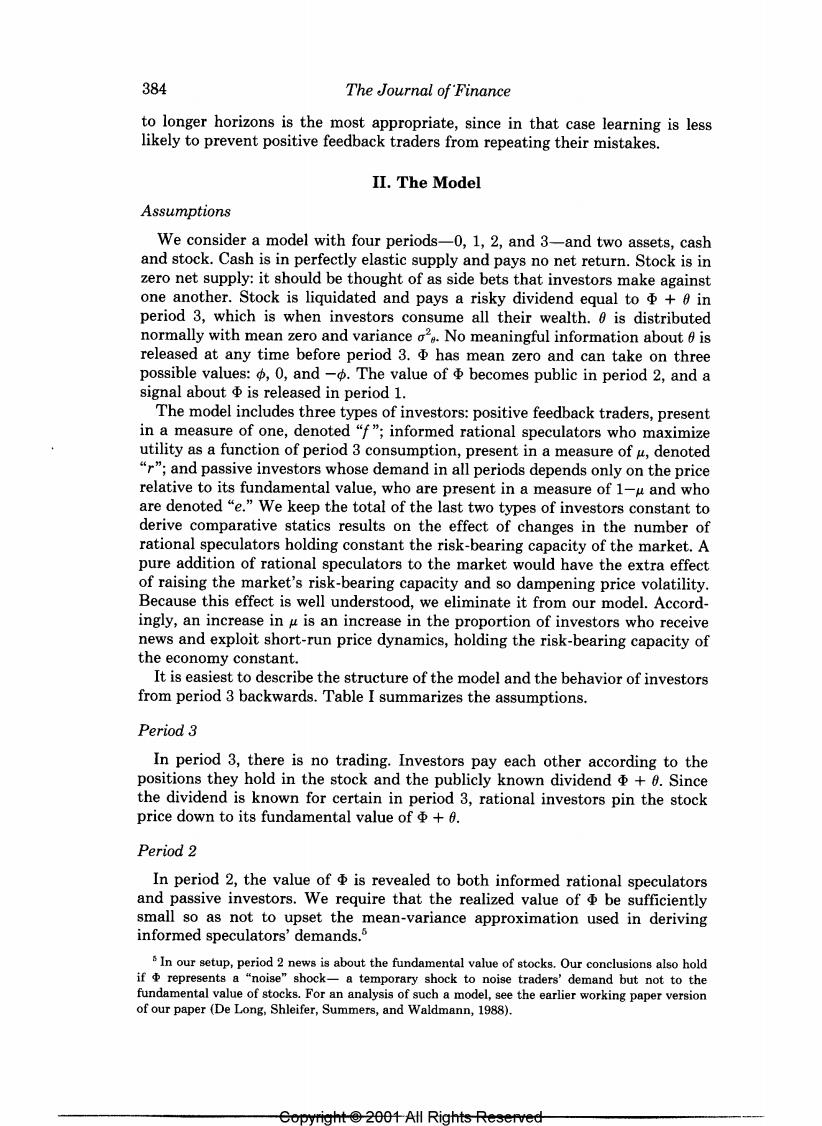
384 The Journal of Finance to longer horizons is the most appropriate,since in that case learning is less likely to prevent positive feedback traders from repeating their mistakes. II.The Model Assumptions We consider a model with four periods-0,1,2,and 3-and two assets,cash and stock.Cash is in perfectly elastic supply and pays no net return.Stock is in zero net supply:it should be thought of as side bets that investors make against one another.Stock is liquidated and pays a risky dividend equal to in period 3,which is when investors consume all their wealth.0 is distributed normally with mean zero and variance o.No meaningful information about 6 is released at any time before period 3.has mean zero and can take on three possible values::φ,0,and-p.The value ofΦbecomes public in period2,anda signal about is released in period 1. The model includes three types of investors:positive feedback traders,present in a measure of one,denoted "f";informed rational speculators who maximize utility as a function of period 3 consumption,present in a measure of denoted "r";and passive investors whose demand in all periods depends only on the price relative to its fundamental value,who are present in a measure of 1-u and who are denoted "e."We keep the total of the last two types of investors constant to derive comparative statics results on the effect of changes in the number of rational speculators holding constant the risk-bearing capacity of the market.A pure addition of rational speculators to the market would have the extra effect of raising the market's risk-bearing capacity and so dampening price volatility. Because this effect is well understood,we eliminate it from our model.Accord- ingly,an increase in u is an increase in the proportion of investors who receive news and exploit short-run price dynamics,holding the risk-bearing capacity of the economy constant. It is easiest to describe the structure of the model and the behavior of investors from period 3 backwards.Table I summarizes the assumptions. Period 3 In period 3,there is no trading.Investors pay each other according to the positions they hold in the stock and the publicly known dividend+0.Since the dividend is known for certain in period 3,rational investors pin the stock price down to its fundamental value of+6. Period 2 In period 2,the value of is revealed to both informed rational speculators and passive investors.We require that the realized value of be sufficiently small so as not to upset the mean-variance approximation used in deriving informed speculators'demands.5 In our setup,period 2 news is about the fundamental value of stocks.Our conclusions also hold if represents a "noise"shock-a temporary shock to noise traders'demand but not to the fundamental value of stocks.For an analysis of such a model,see the earlier working paper version of our paper(De Long,Shleifer,Summers,and Waldmann,1988). Copyright©2o0升All Rights Reserved

Positive Feedback Investment Strategies 385 Table I Structure of the Model Quantities demanded by different classes of investors by period and events that reveal information to different classes of investors.8 and a are parameters that determine the slopes of positive feedback traders'and passive investors'demand curves.po,p,and pa are asset prices in periods 0,1,2,and 3, respectively.Di and Dare rational speculators'period 1 and 2 demands,respectively. Total Demands of: Positive Informed Feedback Rational Period Event Traders Passive Investors Speculators 0 None,benchmark period 0 0 optimally chosen (=0) 1 Speculators receive a signal e of 0 -P1 optimally chosen the period 2 fundamental shock (=Di) 2 Passive investors learn B(p1-Po) -x(p2-中) optimally chosen (=D) 3 Liquidation:dividend +6 de- B(p2-p)-a(p-(Φ+a)optimally chosen: clared,where is an unpredictable 8etsp3=Φ+0 period 3 fundamental shock Positive feedback traders'demand for stock in period 2 is given by D3=(p1-po)=(p1), (1) where p is the price in period 1,po is the price in period 0(which is set equal to 0),and 8 is the positive feedback coefficient.Positive feedback traders'period 2 demands respond to the price change between periods 0 and 1:if the price has risen they buy;if the price has fallen they sell.Importantly,positive feedback traders place a market order today in response to a past price change.A positive 8 thus reflects Andreassen and Kraus's finding that it takes a sequence of rising prices before their experimental subjects begin to chase the trend.This formu- lation does not allow investors to respond instantaneously to price movements; they do not place market orders based on price changes between periods 1 and 2. One way to describe this assumption is that investors react to a past history of capital gains by raising their estimate of the mean rate of return and thus increasing their demand.s Note that in our model no rational investor would follow a positive-feedback trading strategy.Since rational investors know the expected period 3 value of the stock,no rational investor would hold a positive quantity of stocks in period 2 if pz>because such a portfolio is exposed to risk and has a negative expected return.In contrast,positive feedback traders'purchases are invariant to the period 2 price. Informed rational speculators choose their period 2 demand D2 to maximize a mean-variance utility function with risk aversion coefficient y.In period 2,the aggressiveness of rational speculators in betting on reversion to fundamentals is Our working paper version (De Long,Shleifer,Summers,and Waldmann,1988)shows that it is the responsiveness of positive feedback traders to past price changes-the coefficient 8-and not the responsiveness of demand to current price changes that leads to the possibility of destabilizing rational speculation. Copyright 2001 All Riahts Reserved